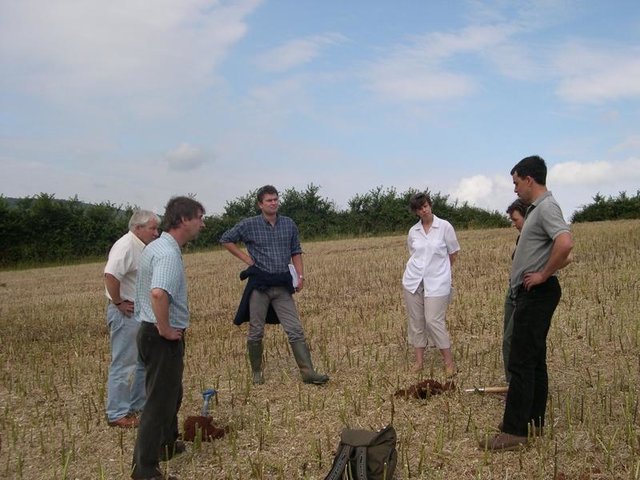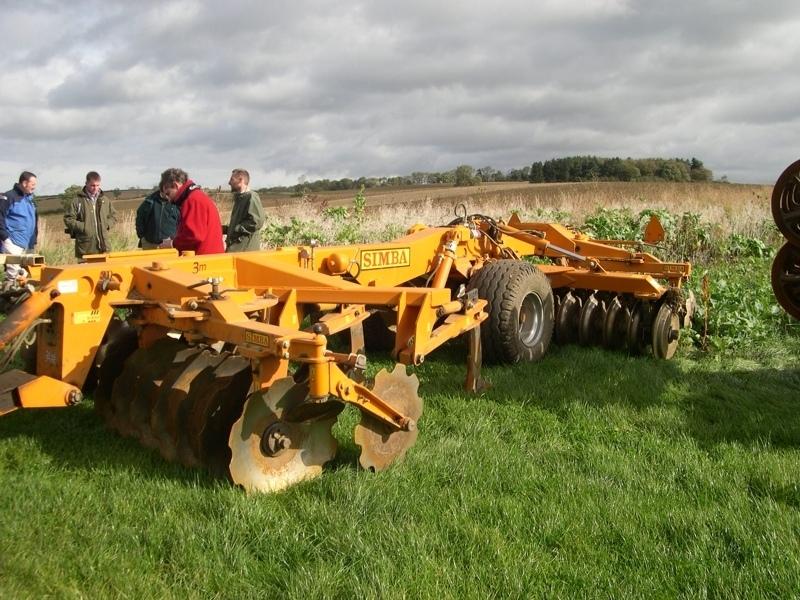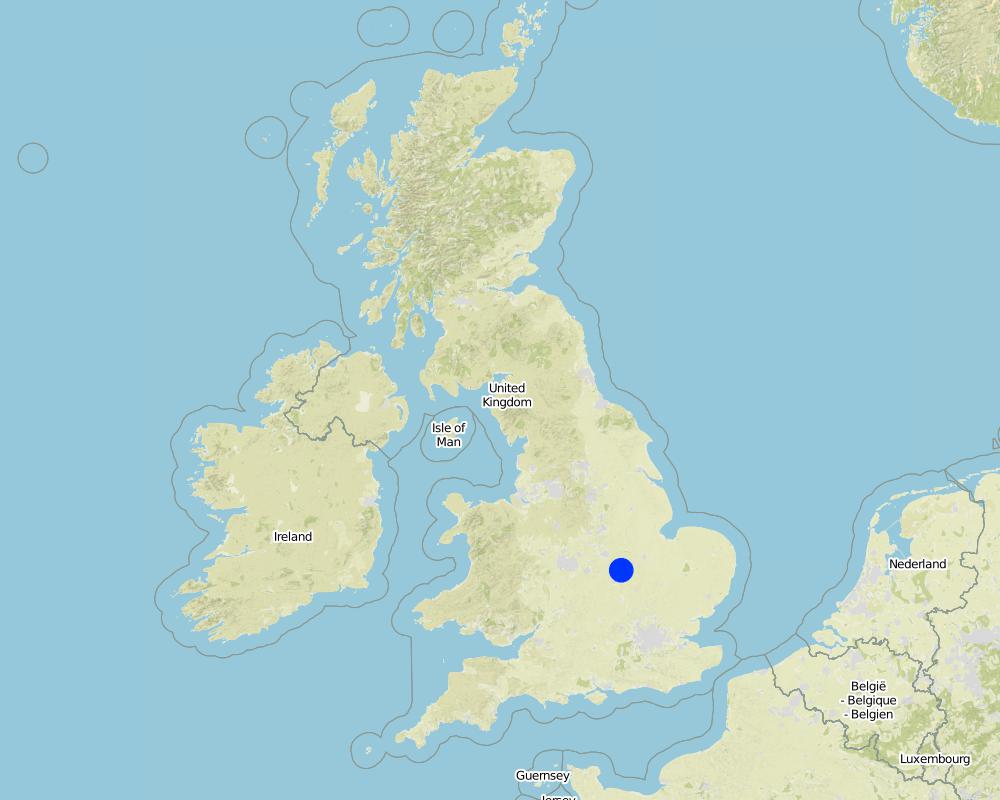Conservation tillage in UK arable cropping: Loddington [United Kingdom]
- Creation:
- Update:
- Compiler: Ceris A. Jones
- Editor: –
- Reviewers: Fabian Ottiger, Alexandra Gavilano
minimum tillage (Eng), non-inversion tillage (Engl); no-tillage (Eng); direct drilling (Eng)
technologies_985 - United Kingdom
View sections
Expand all Collapse all1. General information
1.2 Contact details of resource persons and institutions involved in the assessment and documentation of the Technology
SLM specialist:
Name of project which facilitated the documentation/ evaluation of the Technology (if relevant)
Soil and water protection (EU-SOWAP)Name of the institution(s) which facilitated the documentation/ evaluation of the Technology (if relevant)
Game & Wildlife Conservation Trust - United Kingdom1.3 Conditions regarding the use of data documented through WOCAT
The compiler and key resource person(s) accept the conditions regarding the use of data documented through WOCAT:
Yes
1.5 Reference to Questionnaire(s) on SLM Approaches (documented using WOCAT)

Participatory on-farm resarch and demonstration in UK arable … [United Kingdom]
To find and demonstrate ways of better managing the land.
- Compiler: Ceris A. Jones
2. Description of the SLM Technology
2.1 Short description of the Technology
Definition of the Technology:
Surface cultivation of up to the top 10cm of soil but not complete inversion
2.2 Detailed description of the Technology
Description:
machinery with discs or tines replace the plough for minimal cultivations of the soil. Equally crops may be established by no-tillage/ zero-tillage
Purpose of the Technology: (i) soil protection (ii) improved crop establishment particularly through the speeding up of of operations.
Establishment / maintenance activities and inputs: appropriate machinery, soil condition and following crop all determine establishment. Maintenance: on an annual basis.
Natural / human environment: SOWAP (ww.sowap.org) project working with farmer to protect environment and maintain economic viability
2.3 Photos of the Technology
2.5 Country/ region/ locations where the Technology has been applied and which are covered by this assessment
Country:
United Kingdom
Region/ State/ Province:
Leicestershire
Further specification of location:
Leicestershire
Comments:
Total area covered by the SLM Technology is 0.00063 Km2.
This represents a 630m2 on-farm research and demonstration plot
Map
×2.7 Introduction of the Technology
Comments (type of project, etc.):
From the USA where in te 1930's the 'dust-bowls' necessitated the development of soil conservation in intensive agriculture.
3. Classification of the SLM Technology
3.1 Main purpose(s) of the Technology
- reduce, prevent, restore land degradation
3.2 Current land use type(s) where the Technology is applied

Cropland
- Annual cropping
Annual cropping - Specify crops:
- cereals - wheat (winter)
- legumes and pulses - beans
- oilseed crops - sunflower, rapeseed, other
Number of growing seasons per year:
- 1
Specify:
Longest growing period in days: 330 Longest growing period from month to month: Sep - Aug
Comments:
Major land use problems (compiler’s opinion): Water turbidity, compaction, erosion
Major land use problems (land users’ perception): Compaction
Type of cropping system and major crops comments: wheat - oilseed rape - wheat - beans. Typically these will be winter-sown (Sept) crops rather than spring sown (March)
3.4 Water supply
Water supply for the land on which the Technology is applied:
- rainfed
3.5 SLM group to which the Technology belongs
- improved ground/ vegetation cover
- minimal soil disturbance
3.6 SLM measures comprising the Technology

agronomic measures
- A1: Vegetation/ soil cover
- A2: Organic matter/ soil fertility
- A3: Soil surface treatment
A3: Differentiate tillage systems:
A 3.1: No tillage
Comments:
Main measures: agronomic measures
Type of agronomic measures: cover cropping, mulching, mineral (inorganic) fertilizers, rotations / fallows, breaking compacted topsoil, zero tillage / no-till, minimum tillage, deep tillage / double digging
3.7 Main types of land degradation addressed by the Technology

soil erosion by water
- Wt: loss of topsoil/ surface erosion
- Wo: offsite degradation effects

chemical soil deterioration
- Cn: fertility decline and reduced organic matter content (not caused by erosion)

physical soil deterioration
- Pc: compaction
Comments:
Main type of degradation addressed: Wt: loss of topsoil / surface erosion
Secondary types of degradation addressed: Wo: offsite degradation effects, Cn: fertility decline and reduced organic matter content, Pc: compaction
Main causes of degradation: other human induced causes (specify) (agricultural causes: focus on yields), labour availability (too much labour: attempting to maintain rural employment)
Secondary causes of degradation: education, access to knowledge and support services (lack of knowledge), insufficient time for farmers to consider the issu
3.8 Prevention, reduction, or restoration of land degradation
Specify the goal of the Technology with regard to land degradation:
- prevent land degradation
- reduce land degradation
Comments:
Main goals: mitigation / reduction of land degradation
Secondary goals: prevention of land degradation
4. Technical specifications, implementation activities, inputs, and costs
4.1 Technical drawing of the Technology
Technical specifications (related to technical drawing):
Technical knowledge required for field staff / advisors: moderate
Technical knowledge required for land users: moderate
Main technical functions: improvement of soil structure
Secondary technical functions: control of raindrop splash, control of dispersed runoff: impede / retard, improvement of ground cover, increase in organic matter, increase in soil fertility
Cover cropping
Material/ species: mustard or mustard-rye mixture
Remarks: drilled
Mulching
Material/ species: crop residue
Quantity/ density: up to 5 t/
Remarks: quantity dependent on crop; dispersed over soil surface
Mineral (inorganic) fertilizers
Material/ species: NPK
Quantity/ density: 0.14 t/ha
Remarks: broadcast
Rotations / fallows
Material/ species: cereals/ broad-leaved crops
Remarks: alternate years
Breaking compacted topsoil
Remarks: as appropriate
Deep tillage / double digging
Remarks: as appropriate
4.2 General information regarding the calculation of inputs and costs
other/ national currency (specify):
UK pounds (£)
If relevant, indicate exchange rate from USD to local currency (e.g. 1 USD = 79.9 Brazilian Real): 1 USD =:
0.56
Indicate average wage cost of hired labour per day:
155.00
4.3 Establishment activities
Comments:
Additional info: - Year 1: consolidation: October / per crop - Year2: chop straw close to soil surface: harvest / annual - Year2: incorporate straw and prepare seed bed: September / annual - Year2: drill mustard-rye cover crop: September / annual - Year2: drill crop (2.5-4cm depth): March / once per crop - Year 3: chop straw close to soil surface: harvest / annual - Year3: incorporate straw and overcome compaction: October / per crop - Year3: additional cultivation: October / per crop - Year3: drill crop (2.5-4cm depth): October / once per crop - Year3: consolidation: October / per crop
4.5 Maintenance/ recurrent activities
| Activity | Timing/ frequency | |
|---|---|---|
| 1. | Year1: chop straw close to soil surface | harvest / annual |
| 2. | Year1: drill mustard cover crop | after harvest / annual |
| 3. | Year1: incorporate straw and cover crop | September / per crop |
| 4. | Year1: additional cultivation | October / per crop |
| 5. | Year 1: drill crop (4cm depth) (More in Annex 3) | October / once per crop |
4.6 Costs and inputs needed for maintenance/ recurrent activities (per year)
| Specify input | Unit | Quantity | Costs per Unit | Total costs per input | % of costs borne by land users | |
|---|---|---|---|---|---|---|
| Labour | drill cover crop (year 1) | ha | 1.0 | 67.0 | 67.0 | 100.0 |
| Labour | drill cover crop (year 2) | ha | 1.0 | 128.0 | 128.0 | 100.0 |
| Equipment | Machine use | ha | 1.0 | 204.0 | 204.0 | 100.0 |
| Equipment | Machine hours (year 2) | ha | 1.0 | 67.0 | 67.0 | 100.0 |
| Equipment | Machine hours (year 3) | ha | 1.0 | 236.0 | 236.0 | 100.0 |
| Plant material | Seeds | ha | 1.0 | 68.0 | 68.0 | 100.0 |
| Plant material | Seeds (kg) cover crop (year 2) | ha | 1.0 | 68.0 | 68.0 | 100.0 |
| Total costs for maintenance of the Technology | 838.0 | |||||
| Total costs for maintenance of the Technology in USD | 1496.43 | |||||
Comments:
Machinery/ tools: Simba Solo, Cambridge rollers, Vaderstad drill
Per hectare of land where technology applied. The costs listed are for crop establishment costs only as all other costs (seed, fertiliser, pesticide) are identical to those incurred by other technologies (UNK1a, UNK1c) undertaken on this farm.
4.7 Most important factors affecting the costs
Describe the most determinate factors affecting the costs:
Equipment costs, slope (higher horse power required for steeper slopes), time taken for operation
5. Natural and human environment
5.1 Climate
Annual rainfall
- < 250 mm
- 251-500 mm
- 501-750 mm
- 751-1,000 mm
- 1,001-1,500 mm
- 1,501-2,000 mm
- 2,001-3,000 mm
- 3,001-4,000 mm
- > 4,000 mm
Specify average annual rainfall (if known), in mm:
660.00
Agro-climatic zone
- sub-humid
5.2 Topography
Slopes on average:
- flat (0-2%)
- gentle (3-5%)
- moderate (6-10%)
- rolling (11-15%)
- hilly (16-30%)
- steep (31-60%)
- very steep (>60%)
Landforms:
- plateau/plains
- ridges
- mountain slopes
- hill slopes
- footslopes
- valley floors
Altitudinal zone:
- 0-100 m a.s.l.
- 101-500 m a.s.l.
- 501-1,000 m a.s.l.
- 1,001-1,500 m a.s.l.
- 1,501-2,000 m a.s.l.
- 2,001-2,500 m a.s.l.
- 2,501-3,000 m a.s.l.
- 3,001-4,000 m a.s.l.
- > 4,000 m a.s.l.
Comments and further specifications on topography:
Landforms: Hill slopes (some slopes < 8%)
5.3 Soils
Soil depth on average:
- very shallow (0-20 cm)
- shallow (21-50 cm)
- moderately deep (51-80 cm)
- deep (81-120 cm)
- very deep (> 120 cm)
Soil texture (topsoil):
- medium (loamy, silty)
- fine/ heavy (clay)
Topsoil organic matter:
- medium (1-3%)
If available, attach full soil description or specify the available information, e.g. soil type, soil PH/ acidity, Cation Exchange Capacity, nitrogen, salinity etc.
Soil fertility is medium
Soil drainage/infiltration is good
Soil water storage capacity is high
5.6 Characteristics of land users applying the Technology
Market orientation of production system:
- commercial/ market
Off-farm income:
- 10-50% of all income
Relative level of wealth:
- average
Level of mechanization:
- mechanized/ motorized
Indicate other relevant characteristics of the land users:
Population density: 10-50 persons/km2
Annual population growth: 1% - 2%
50% of the land users are rich and own 60% of the land.
50% of the land users are average wealthy and own 40% of the land.
5.7 Average area of land used by land users applying the Technology
- < 0.5 ha
- 0.5-1 ha
- 1-2 ha
- 2-5 ha
- 5-15 ha
- 15-50 ha
- 50-100 ha
- 100-500 ha
- 500-1,000 ha
- 1,000-10,000 ha
- > 10,000 ha
Comments:
250 ha of cultivated arable land
5.8 Land ownership, land use rights, and water use rights
- Trust
- Trust
- Trust
6. Impacts and concluding statements
6.1 On-site impacts the Technology has shown
Socio-economic impacts
Income and costs
farm income
Comments/ specify:
Uncertain after only 3 years
Socio-cultural impacts
Impression of the technology
Comments/ specify:
Land manager enthusiastic about the technology
Ecological impacts
Soil
soil moisture
soil cover
Comments/ specify:
Residue and/or cover crop
soil loss
Quantity before SLM:
0.01
Quantity after SLM:
0
Biodiversity: vegetation, animals
animal diversity
Comments/ specify:
Higher earthworm populations, improved soil microbiology
Other ecological impacts
Soil fertility
Input constraints
Comments/ specify:
Better range of herbicide options
Cost of cover crop seed
Comments/ specify:
Can negate the cost savings achieved through the lower crop establishment costs
Soil erosion locally
Comments/ specify:
Immediately after drilling cover crop
6.2 Off-site impacts the Technology has shown
groundwater/ river pollution
Comments/ specify:
Reduced nutrient loss
6.4 Cost-benefit analysis
How do the benefits compare with the establishment costs (from land users’ perspective)?
Short-term returns:
neutral/ balanced
Long-term returns:
neutral/ balanced
How do the benefits compare with the maintenance/ recurrent costs (from land users' perspective)?
Short-term returns:
neutral/ balanced
Long-term returns:
neutral/ balanced
6.5 Adoption of the Technology
Comments:
100% of land user families have adopted the Technology without any external material support
1 land user families have adopted the Technology without any external material support
Comments on spontaneous adoption: survey results
There is a little trend towards spontaneous adoption of the Technology
Comments on adoption trend: Currently about 40% of the UK practices conservation tillage
6.7 Strengths/ advantages/ opportunities of the Technology
| Strengths/ advantages/ opportunities in the land user’s view |
|---|
|
timeliness How can they be sustained / enhanced? good planning |
| improved biodiversity |
| improved soil organic matter |
| Strengths/ advantages/ opportunities in the compiler’s or other key resource person’s view |
|---|
|
cost effectiveness How can they be sustained / enhanced? increase are under cultivation (economy of scale) |
|
improved soil quality How can they be sustained / enhanced? continuing practice; retention of straw |
| increased soil biodiversity |
| improved water quality |
| increased work rate |
6.8 Weaknesses/ disadvantages/ risks of the Technology and ways of overcoming them
| Weaknesses/ disadvantages/ risks in the land user’s view | How can they be overcome? |
|---|---|
| as above |
| Weaknesses/ disadvantages/ risks in the compiler’s or other key resource person’s view | How can they be overcome? |
|---|---|
| potential for increased weed populations | improved rotations, greater use of cover crops to compete with weeds |
| cost of cover crop seed and lack of appropriate species | greater use will encourage lower cost and more speciesw research |
7. References and links
7.1 Methods/ sources of information
Links and modules
Expand all Collapse allLinks

Participatory on-farm resarch and demonstration in UK arable … [United Kingdom]
To find and demonstrate ways of better managing the land.
- Compiler: Ceris A. Jones
Modules
No modules





